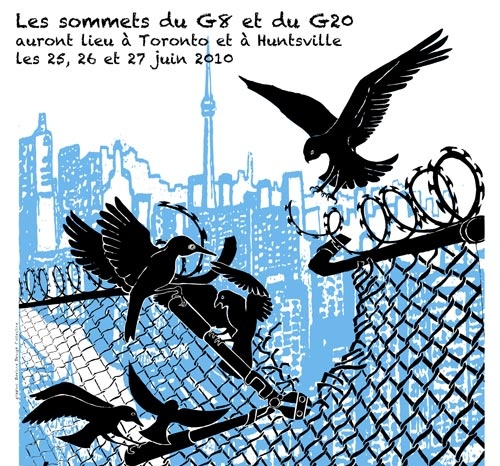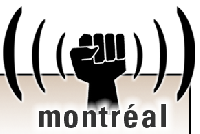 |
 |
 |
 |
 |
 |
|
 |
 |
 |
 |
 |
 |
 |
Régions du Québec |  |
 |
 |
|
 |
 |
|
 |
 |
|
 |
 |
 |
 |
 |
 |
Rubriques (sujets) |  |
 |
 |
|
 |
 |
|
 |
|
 |
 |
 |
Ordinary Merida students at ULA can't really handle UZIs with such precision...
VHeadline.com en Español news chief, Jesus Nery Barrios writes: Traditionally, the student movement at the University of the Andes (ULA) in Merida, in southwestern Venezuela, has been very combative while progressive within the context of social struggles ... especially since the sixties, with two political currents dominating and leading it: the left (led by the Venezuelan Communist Party -- Juventud Comunista -- and other small groups, mainly splinters from parties like Movimiento al Socialismo, Liga Socialista, Bandera Roja, Movimiento Electoral del Pueblo (itself a split from AD), Movimiento 21, etc.); and the right (led by political groups and movements which were extensions of the traditional ruling parties, Accion Democratica and Copei.
They were known within the university itself by the number assigned by the election commission: i.e. traditionally, the AD student movement was plancha 5; Copei (Democracia Cristiana Universitaria and Juventud Revolucionaria Copeyana) was plancha 2.
The remaining political groups at the university were independent movements with moderate ideologies and little political indoctrination ... they only increased their "presence" at election times.
Traditionally, the left always occupied student authority posts: student centers in each school, the university federation center (FCU) and student representatives in every faculty council and in the University Council ... the main decision instance at ULA.
Only since the middle of the 1980s, has the right wing sporadically reached some of these posts ... democratically and directly elected by all the students.
Concerning Merida, the student movement has always been at the forefront of social struggle in Venezuela with peaceful and non-peaceful demonstrations on the streets against repressive politics of the traditional parties who ruled the country for 40 years. The small city currently has a population of 700,000 and is well-known for its natural landscape and its main tourism attraction: the highest and longest cable-car in the world, reaching to the top of Pico Bolivar, Venezuela's highest mountain (5,007 meters above sea level).
Under the 40 years of questionable "democratic" rule, many student leaders were killed at the hands of the local police, National Guard and even the Army, which was usually deployed on the streets "to bring back peace."
Pictures and names can still be seen listed on a wall in the Medicine School. Some university buildings are named after some of them too ... to let everyone who visits Merida remember the way the AD and Copei governments (the current opposition to Chavez) treated the students and their demands.
(Curiously, those who currently attack Chavez of "breaking into" ULA, and government officials of "injuring many students" during protests forget to mention that not a single student has been killed during any student protest in the last 7 years.)
When the student movement protested against mediocre educational policies, increases in public transport fares, the irrational lack of capacity at the universities, the lack of financial aid for poor students and against of some national policies that affected the poor majority through unequal distribution of the nation's oil wealth, they only received bullets back ... right to the head.
I have, myself, witnessed many times when taking part in demonstrations in the 80s and 90s, that many of our student leaders went missed, were imprisoned or killed. To this very day, not a single police officer, member of the National Guard or the Army has been charged or prosecuted ... on the contrary, many of those responsible are still free today, running about and crying that Chavez is the worst dictator ever in the whole world.
On March 13, 1987, many young people were celebrating their graduation and there were tailbacks of cars on the streets of Merida, cheering and chanting, as they always do.
* At some point in the celebration, a young man recently graduated from the ULA Law School, Ruben Caravallo, got out of his car outside a house belonging to one Bernardino Navas ... who simply took his revolver and shot him dead, instantly.
The most violent protests that Merida has ever known started as direct consequence of this irrational blood-letting ... there was looting, car burnings and streets blockades lasting three days, forcing the National Guard to take to the streets ... an action that proved to be insufficient, and which forced the then governor to ask President Jaime Lusinchi's (Accion Democratica) government to deploy the Army to restore law and order ... and operation that took a whole month.
That is the date some university leaders like Caracciolo Leon and others took to found "Movimiento Social 13 de Marzo," or M-13, currently led by Nixon Moreno, accused of leading the violent protests that terrorized Merida last week (and a rape attempt on a policewoman too), as part of his peculiar method to lead a protest against an alleged violent action of the Chavez government.
In its beginnings this movement went beyond the walls of the university to participate in some social struggles and had the approval of some people in Merida through displaying no particular political ideology, although its actions proved the contrary.
Even when they took their inspiration from a protest to protest violence against a student, they, themselves, turned violent in each action they took at the University of the Andes, opposing both left and right movements ... but always negotiating with the right traditional movements at highest level, i.e. university and regional government authorities.
That's another tradition within the ULA student movement ... to negotiate privileges (like staying at the university for 13 years -- as in the case of Nixon Moreno -- even when they don't really study) and monetary rewards after they convince students they'll try to improve their conditions during the university election campaign.
It's worth mentioning that one of the most notorious leaders in recent past, Omar Ruiz (former president of FCU, the top student's authority), had had a post in the regional cabinet of former governor (AD) William Davila between 1996 and 1998, when he graduated after 10 years at the ULA ... both opposition and conspirators against President Chavez.
* William Davila, even though he is now politically dead and scorned by the people of Merida because of his unlucky and corrupt government, showed up together with Nixon Moreno and his henchmen to defend what they did last week: blocking the streets, suspending classes, shooting at the police and the National Guard and attempting to rape a policewoman who was directing jammed-up traffic.
That is the reality of the ULA student movement and its leadership ... a mob of gunmen, rapists and students who do not study at all, but enjoy the university privileges: free transportation within the city, almost free canteen, free residence and a very low registration fee ... all paid by the Bolivarian government. Only that now (in 2006, for the first time in history) university authorities are having to report to the national government how the spend their millionaire budget, causing them to protest ... which is maybe one of the reasons why the Dean in charge, Mario Bonucci, supported Nixon's allegations of the National Guard breaking into the university campus without showing any warrant. It maybe also explains why ULA Dean, Lester Rodriguez, joined him saying that he did not see gunmen carrying and/or shooting UZIs, pistols and shotguns when he just arrived right after the events took place.
The reality is that Nixon Moreno is not just negotiating his permanent sinecure at the university with university authorities like Bonucci and Rodriguez, but has been negotiating a "good reward" from the US Embassy in Caracas for provoking acts of violence to give the world media a excellent pretext to claim the Chavez government as being repressive and dictatorial. Moreno has met US ambassador William Brownfield in a hotel in the neighboring state of Barinas; perhaps negotiating with Colombia's Alvaro Uribe to be the next ULA Dean he is now meeting with (right wing) paramilitary forces in Colombia together with Lester Rodriguez.
* Ordinary students can't really handle UZIs with such precision as the gunmen did last week, injuring 26 policemen and one National Guard.
Faced with the apathy of most students at ULA (who barely participate in university elections) and the inability of the left and/or the student movements supporting Chavez policies, the citizens of Merida are defenseless and only hope that the judicial system acts immediately on evidence provided by the Ministry of Interior & Justice to stop violence and chaos promoted by the gangster, Nixon Moreno and his M-13 mob under the democratic and legal shield of the university's autonomy and student rights.
Unfortunately, the judicial system has not been sufficiently reformed enough leaving many crimes still unpunished, like those of the many agrarian leaders killed by large landowners, the Public Prosecutor Danilo Anderson, the citizens killed in Puente Llaguno in Caracas (all of them chavistas).
Meanwhile the perpetrators are still free and un-harmed but crying in all the national and international media "how repressive and dictatorial is this government of Hugo Chavez Frias!"
Jesus Nery Barrios
Jes...@VHeadline.com
| Documents inclus | Taille |
|---|---|
| Pag-10-02-06-06.jpg | 0 octets |
 |
 |
 |
 |
Dossier G20 |  |
 |
 |
|
 |
 |
|
 |
Nous vous offrons plusieurs reportages indépendants et témoignages...

Liste des activités lors de ce « contre-sommet » à Toronto Vous pouvez aussi visiter ces médias alternatifs anglophones... Centre des médias Alternatifs Toronto 2010.mediacoop.net Media Co-op Toronto http://toronto.mediacoop.ca Toronto Community Mobilization www.attacktheroots.net (en Anglais) |
 |
 |
 |
 |
 |
 |
 |
CMAQ: Vie associative |  |
 |
 |
|
 |
 |
|
 |
 Collectif à Québec: n'existe plus. Impliquez-vous ! |
 |
 |
 |
 |
 |
 |
 |
 |
|
 |
 |
 |
Ceci est un média alternatif de publication ouverte. Le collectif CMAQ, qui gère la validation des contributions sur le Indymedia-Québec, n'endosse aucunement les propos et ne juge pas de la véracité des informations. Ce sont les commentaires des Internautes, comme vous, qui servent à évaluer la qualité de l'information. Nous avons néanmoins une
Politique éditoriale
, qui essentiellement demande que les contributions portent sur une question d'émancipation et ne proviennent pas de médias commerciaux.
This is an alternative media using open publishing. The CMAQ collective, who validates the posts submitted on the Indymedia-Quebec, does not endorse in any way the opinions and statements and does not judge if the information is correct or true. The quality of the information is evaluated by the comments from Internet surfers, like yourself. We nonetheless have an
Editorial Policy
, which essentially requires that posts be related to questions of emancipation and does not come from a commercial media.


